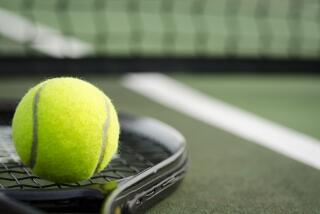USTA Hopes New Policies Will Expand Participation, Talent
- Share via
SAN DIEGO — To avoid a potential “Why Johnny Can’t Play Tennis” sequel to “Why Johnny Can’t Read,” the United States Tennis Assn. has approved a junior development program for all age groups. Policy changes will have the most widespread effect on the boys’ and girls’ 12-and-under division.
The most drastic changes will be in the phasing out of rankings and national championship tournaments for the 12s.
Next year will be the last for national rankings in the 12s, and there will be no more clay court, hardcourt and indoor championships. They will be replaced by USTA Zone Team Championships, which will be held at four sites across the country, allowing more players to compete--256 versus the 128 who play the championship now--and cutting the extreme costs to travel to one location.
The zone competitions will feature a round-robin, no-elimination format, guaranteeing each player six singles and six doubles matches. They will be followed with educational and developmental seminars.
And although the main national championship tournament for 12s--such as the boys are playing this week at Morley Field--will be back in 1989, it will be replaced in 1990 by the USTA National Team Challenge Cup, in the interest of stressing team rather than individual play.
“By the team concept,” said USTA national coach Lynne Rolley, “we want to instill how much fun it can be to have a team made up of individuals.”
Before the boys’ 12s championships began earlier in the week, three USTA representatives--Rolley, Paul Roetert, sports science coordinator of research, and volunteer Barbara Smith, a member of the 12s implementation subcommittee--told athletes, parents and coaches what changes were being made and why.
Smith said parents were, for the most part, receptive to the changes. A similar pitch was made at the girls’ 12s in Boca Raton, Fla.
“There were two major thrusts that brought about the changes” and the endorsement of the USTA Junior Development Program, said Smith, of Austin, Tex.
“Sports medicine was the first thrust,” she said. “There has to be injury prevention for the kids in their pre-puberty years.”
Roetert said planned seminars will teach young players “what to eat, how to eat, proper conditioning, flexibility,” and other aspects of overall fitness.
“The second thrust,” Smith said, “was the realization that America didn’t have a large enough pool of potential champions.”
According to Smith, junior tennis has players who can play on clay or grass, but few are all-surface players. Likewise, there are baseline players and serve-and-volleyers, but few with all-around games.
“The goals (of the new program) are to increase the pool of juniors playing tennis at every level: grass-roots, local and up in the ranks, and to allow every player to develop to his full potential,” she said.
The program was approved by the USTA at its annual meeting in March.
“We want to emphasize that a 12-year-old enjoy the game,” Rolley said. “We want them to keep their options open, not to focus all their energy on the moment, rather to look at the long-range aspect of the game. Some of those options may include high school, recreational and, for a few, professional tennis.”
Said Roetert: “The American system has traditionally taught kids to be more quantitative than qualitative in their training. Now, we’re trying to stop burnout. We want them to have other sports they’re interested in.”
Smith said that co-chairman Arthur Ashe and members ofthe USTA Player Development Committee--including Stan Smith, Billie Jean King, Dennis Ralston and Jack Kramer--”did the work last year and came out with the original proposal for a revamped program. Before, we had a tournament-based system; now we have a development-based system.”
Final budgeting and specific implementation for this program, which the USTA hopes will include training camps for the top players in the country, establishment of four to six regional training centers and 100 local training centers to cover the major metropolitan centers around the country, will be discussed at the semi-annual meeting of the USTA at the U.S. Open in September.
Boys 12s Notes
Scott Lippitt of Rancho Santa Fe is the sole San Diego-area survivor in the remaining singles draw of 32. Lippitt had to fend off Ryan Rader of Aledo, Ill., 6-7, 6-4, 7-5. He will face No. 8 Paul Goldstein of Rockville, Md., today at 3 p.m. . . . Seventh-seeded Brian Getz of Coral Springs, Fla., was beaten by Zak Blanchard of New Iberia, La., 7-6, 6-4. . . . Top-seeded Scott Humphries of Greeley, Colo., swept past Richi Patel of Bradenton, Fla., 6-0, 6-0. No. 2-seeded B.J. Stearns of Seminole, Fla., defeated Daniel Rothschild of Garden City, N.Y., 6-3, 6-1, and No. 4-seeded Ry Tarpley of Milton, Mass., defeated Arthur Novoseletsky of Lauderdale Lakes, Fla., 6-0, 6-1.
More to Read
Get our high school sports newsletter
Prep Rally is devoted to the SoCal high school sports experience, bringing you scores, stories and a behind-the-scenes look at what makes prep sports so popular.
You may occasionally receive promotional content from the Los Angeles Times.






